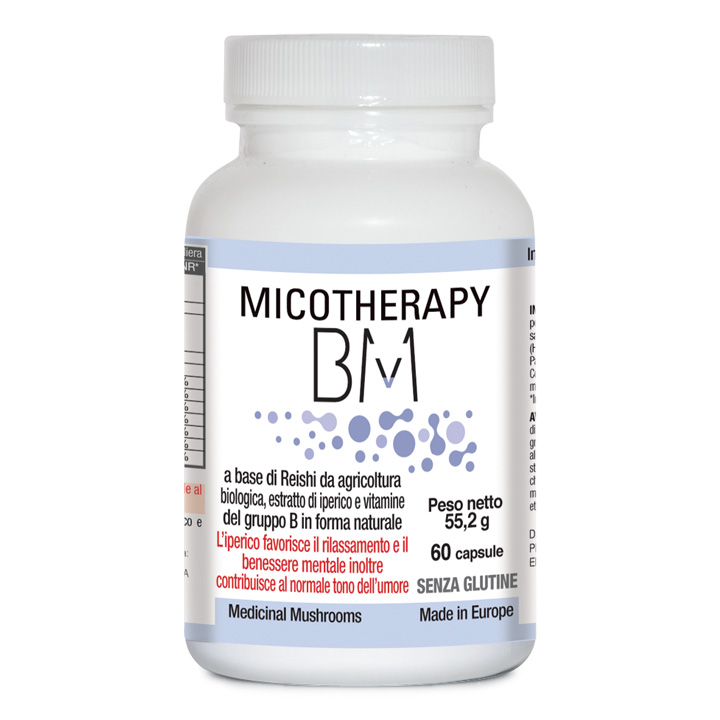
Psycho-physical rebalancing support
Food supplement containing organically grown Reishi, plant extracts and B-complex vitamins in natural form.
HEALTH BENEFITS:
Formulated with Reishi dry extract from organic sources, Micotherapy BM carries out a natural calming action, alleviating symptoms of anxiety in a natural way. Thanks to the synergistic action of its components, it helps to improve the quality of sleep and the ability to manage psycho-physical stress, helping to provide greater mental clarity.
INGREDIENTS:
- Reishi (Ganoderma lucidum) dry extract titrated at 25% in polysaccharides
- Vegetable complex of B-complex vitamins from buckwheat
- Hypericum grass dry extract (titrated at 0.3% in hypericin)
- Passiflora flowers dry extract (titrated at 3.5% in flavonoids)
- Centella leaves dry extract (titrated at 40% in triterpenes)
- Vegetable cellulose capsules
PROPERTIES OF THE INGREDIENTS:
- Reishi: also known as the ‘mushroom of a thousand Years’ and the ‘mushroom of immortality’ because it is believed to promote longevity, Reishi is traditionally used as a remedy for restoring balance to the body, consequently increasing resistance to disease. It also acts on the nervous system and on the release of endogenic endorphins, producing a naturally calming effect, and improves sleep quality and the body’s ability to recover.
- Hypericum dry extract:it aids relaxation and mental wellbeing, contributing to normal moods, and is commonly used to treat slight or moderate depression accompanied by anxiety, fatigue and irregular sleep patterns.
- Passiflora: it has a calming, sedating action on the central nervous system, with significant effects on stress, nervousness and insomnia.
- Centella:it has an anti-inflammatory action and increases brain oxygenation, thus improving mental clarity, concentration and sleep rhythms.
- B-complex vitamins in natural form:highly bio-available, they are important for maintaining the balance of the nervous system and protecting both its structure and functions.
DIRECTIONS:
2 capsules per day, preferably away from meals
PACK:
pack containing 60 capsules
vegetable cellulose capsules.
Notes:
Gluten free
ICEA VEGAN certified product
Made in Europe
| AVERAGE CONTENT OF INGREDIENTS | PER DAILY DOSE (2 CAPSULES) | RDA |
| Reishi dry extract | 660 mg | |
| Polysaccharide content | 165 mg | |
| Buckwheat | 400 mg | |
| Hypericum dry extract | 235 mg | |
| Daily intake of Hypericin | 0,7 mg | |
| Hyperforin/hypericin ratio | no higher than 7 | |
| Passiflora dry extract | 200 mg | |
| Centella dry extract | 100 mg | |
| Vitamin B1 (thiamine) | 0,8 mg | 73% |
| Vitamin B2 (riboflavin) | 1,3 mg | 93% |
| Vitamin B3 (niacin) | 14,3 mg | 89% |
| Vitamin B5 (pantothenic acid) | 5,5 mg | 91% |
| Vitamin B6 (pyridoxine) | 0,8 mg | 57% |
| Folic acid | 180 mcg | 90% |
| Vitamin B12 (methylcobalamin) | 1,6 mcg | 64 % |
Bibliography:
- Mizuno, T. (1996). Oriental Medicinal tradition of “Ganoderma lucidum (Reishi)” in China. In T. Mizuno & B.-K. Kim(Eds.), Ganoderma lucidum (pp. 101-106). Seoul, Korea : IlYang Pharm. Co. Ltd
- Kim KC, Kim IG. Ganoderma lucidum extract protects DNA from strand breakage caused by hydroxyl radical and UV irradiation.Int J Mol Med 1999 Sep;4(3):273-7
- Wachtel-Galor S, Szeto YT, Tomlinson B, et al. Ganoderma lucidum (‘Lingzhi’); acute and short-term biomarker response to supplementation. Int J Food Sci Nutr. Feb 2004;55(1):75-83
- T.A. Ajith, N.P. Sudheesh, D. Roshny, G. Abishek and K.K. Janardhanan. Effect of Ganoderma lucidum on the activities of mitochondrial dehydrogenases and complex I and II of electron transport chain in the brain of aged rats Experimental Gerontology Volume 44, Issue 3, March 2009, Pages 219-223
- Tang W, Gao Y, Chen G, et al. A Randomized, Double-Blind and Placebo-Controlled Study of a Ganoderma lucidum Polysaccharide Extract in Neurasthenia. J Med Food. 2005;8:53-58
- CS Lai, MS Yu, WH Yuen, KF So, SY Zee, and RC Chang. Antagonizing beta-amyloid peptide neurotoxicity of the anti-aging fungus Ganoderma lucidum. Brain Res, Jan 2008; 1190: 215-24
- R Zhang, S Xu, Y Cai, M Zhou, X Zuo and P Chan. Ganoderma lucidum Protects Dopaminergic Neuron Degeneration Through Inhibition of Microglial Activation. eCAM Advance Access published July 16, 2009
- ZY Zhou, YP Tang, J Xiang, P Wua, HM Jin, Z Wang, M Mori, and DF Cai. Neuroprotective effects of water-soluble Ganoderma lucidum polysaccharides on cerebral ischemic injury in rats. J Ethnopharmacol, August 19, 2010; 131(1): 154-64
- Zhou Y, Qu ZQ, Zeng YS, Lin YK, Li Y, Chung P, Wong R, Hagg U. Neuroprotective effect of preadministration with Ganoderma lucidum spore on rat hippocampus. Exp Toxicol Pathol, November 1, 2012; 64(7-8): 673-80
- Ajith TA et al. Effect of Ganoderma lucidum on the activities of mitochondrial dehydrogenases and complex I and II of electron transport chain in the brain of aged rats. ExpGerontol 2009; 44(3):219-223
- Ding H, et al. Ganoderma lucidum extract protects dopaminergic neurons through inhibiting the production of inflammatory mediators by activated microglia. Sheng Li Xue Bao. 2010 Dec 25;62(6):547-54
- Zhao HB, et al. Polysaccharide extract isolated from ganoderma lucidum protects rat cerebral cortical neurons from hypoxia/reoxygenation injury. J Pharmacol Sci. 2004 Jun;95(2):294-8
- Zhang R, et al. Ganoderma lucidum protects dopaminergic neuron degeneration through inhibition of microglial activation. Evid Based Complement Alternat Med. 2011;2011:156810
- Chen LW, Horng LY, Wu CL, Sung HC, Wu RT. Activating mitochondrial regulator PGC-1alpha expression by astrocytic NGF is a therapeutic strategy for Huntington’s disease. Neuropharmacology. 2012 May 24
- XY Cui, SY Cui, J Zhang, ZJ Wang, B Yu, ZF Sheng, XQ Zhang, and YH Zhang Extract of Ganoderma lucidum prolongs sleep time in rats. J Ethnopharmacol, February 15, 2012; 139(3): 796-800
- Lee JM et al. Inhibition of lipid peroxidation and oxidative DNA damage by Ganoderma lucidum. Phytotherapy Res; 15: 245-249
- Campanini E. – “ Dizionario di fitoterapia e piante medicinali”– Milano, 2012
- Fassina G. – “Lezioni di farmacologia”- Cedam, Padova, 1995
- Speroni E. et al. Neuropharmacological activity of extracts from Passiflora incarnata. Planta Med. 54, 488-491, 1988
- Bourin A.V. et al. A combination of plant extracts in the treatment of outpatients with adjustement disorders with anxious mood. Controlled study versus placebo. Fundam. Clin. Pharmacol. 11, 127-132, 1997
- Speroni E. et al. Role of chrisin in the sedative effects of Passiflora incarnata L. Phytother. Res. 10, suppl. 1, S 98- S 100, 1996
- Speroni E. et al. Sedative effects of crude extracts of Passiflora incarnata after oral administration. Phytother. Res. 10, suppl. 1, S 92-S 94, 1996
- Dhawan K. et al. Anxiolytic activity of aerial and underground parts of Passiflora incarnata. Fitoterapia 72, 922-926, 2001
- Dhawan K. et al. Anti-anxiety studies on extracts of Passiflora incarnata Linneaus. J. Ethnopharmacol. 78, 165-170, 2001
- Akhondzadek S. et al. Passionflower in the treatment of generalized anxiety: a pilot double blind randomized controlled trial with oxazepam. J. Clin. Pharm. Ther. 26, 363-377, 2001
- Dhawan K. et al. Comparative Anxiolytic Activity Profile of Various Preparations of Passiflora incarnata Linneaus: A Comment on Medicinal Plants’ Standardization. J Altern Complement Med 8(3):283-91, 2002
- A Szegedi, R Kohnen, A Dienel, M Kieser. Acute treatment of moderate to severe depression with hypericum extract WS 5570 (St John’s wort): randomised controlled double blind non-inferiority trial versus paroxetine. BMJ 2005;330:503
- Monograph. Hypericum perforatum. Altern Med Rev. 2004 Sep; 9 (3):318-25
- Linde K, Mulrow CD, Berner M, Egger M. St John’s worth for depression. Cochrane Database Syst Rev. 2005 Apr 18;(2):CD000448
- James, J.T.; Dubery, I.A. Pentacyclic Triterpenoids from the Medicinal Herb, Centella asiatica (L.) Urban. Molecules 2009, 14, 3922-3941
- Blumenthal M et al. The Complete German Commission E Monographs: Therapeutic Guide to Herbal Medicines. Klein S, Rister RS, translators. Austin (TX): American Botanical Council; Boston (MA): Integrative Medicine Communications; 1998



